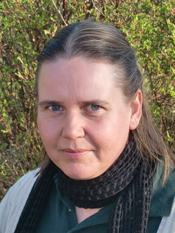Examples of research projects
Germination ecology of annual weeds
Seeds are amazing; they can record what happens around them and use that information to germinate during the right circumstances at exactly the right time. Seeds just not simply register the momentary situation and respond with germination if suitable; a lot of species have in addition seed dormancy, which means that the seeds require some specific environmental event in the past life story before they germinate.
My studies of weed seeds have given interesting knowledge. Some examples:
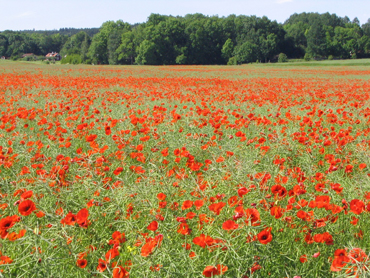
Flowering field poppy, infesting an oil-seed rape field in Sweden.
Papaver rhoeas (common poppy, field poppy) germinates during autumn in warmer climates and during spring in cooler climates, without special adaptation to the different climates. This is achieved by seed dormancy decreasing during warm periods and increasing during periods around 0-5 °C. The result is germination in autumn in warmer environments (the plants overwinter as rosettes). In cold climates, the summer is too cool to be efficient for dormancy alleviation, and the following autumn too cold and short for germination; thus they should never germinate. However, when winter temperatures are freezing, and there is no snow to cover soil surface, the seeds are not exposed to the dormancy-inducing temperature. The fraction that was not fully dormant in late summer therefore germinates in spring, thus performing like a summer annual.
Conyza bonariensis (hairy fleabane, flax-leaf fleabane) and Conyza canadensis (horseweed fleabane, horseweed) co-occur in warm temperate climate, but in cold temperate climate there is only C. canadensis. This is because the species have different germination requirements. They germinate to a high extent when newly dispersed but C. bonariensis germinates at lower temperatures than C. canadensis. In warmer climate, for example in France, both species are mainly winter annuals and germinate soon after seed dispersal in autumn and overwinter as rosettes. In colder climate, for example in Sweden, C. canadensis is a summer annual. At seed dispersal in autumn it is too cold for C. canadensis to germinate, and it overwinter as seed and germinates in spring. For C. bonariensis, the low autumn temperature does not prevent germination, and as winter comes soon the young seedlings do not survive. Thus, even though it may seem counter-intuitive, the species that germinates at low temperature soon after dispersal is not well adapted to cold climate.
The drought tolerant Ethiopian crop enset (false banana)
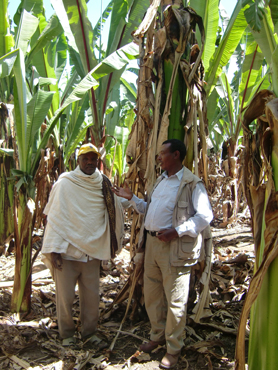
Ato Eyoel Fuge and Dr Abitew Lagibo Dalbato in the former's enset plantation in Doyogena, Ethiopia.
Enset (Ensete ventricosum, Abyssinian banana, false banana) has been cultivated in parts of Ethiopia since ancient times. Enset is a drought-tolerant, high-yielding and multi-purpose crop. Its nutritive value is similar to potato. It provides important ecosystem services and contributes to agro-biodiversity. Enset could be a part of sustainable agricultural development and livelihood security in much larger areas than where currently used. However, as noted by the Worldwatch Institute, this indigenous African crop has received little research or extension support.
I am leading a project, funded by Formas, about enset. Other scientists involved are Dr. Tamado Tana (Agronomist), Dr. Abitew Lagibo Dalbato (Horticulturalist) and Mikias Yeshitila (long-time national coordinator for enset research in Ethiopia). The aims are to (1) investigate and compare different traditional methods for vegetative propagation, to contribute to fact-based and proper recommendations and (2) to investigate early growth of seedlings, to propose a cultivation method and open up for breeding.
Enset is traditionally propagated vegetatively, so each of several hundred landraces is also a clone. Therefore, farmers know a new plant will have the same characteristics as the previous. However, the genetic recombination in sexual reproduction is missing, and therefore the variation used for traditional breeding by crossing and selection is lacking.
So far, our results show that corms can be split in order to increase the number of sprouts while still give a number of very large sprouts. Contradictory to traditional advice, we found that watering of newly planted corms was beneficial and led to shortened time to emergence. Germination differed between mother plants, while seedlings grew readily in local soil, substantially enhanced by adding manure. Seedlings planted in the field, with manure, had a base circumference of 1.5-2 m within 24 months, and four out of ten flowered, which is unusually early.
Based on our results, propagation advice can be improved and breeding can be initiated. Further studies should be done to investigate possible physiological seed dormancy and to investigate the growth requirements of saplings and seedlings in more detail.
There are suggestions to encourage enset cultivation by distributing seeds or seedlings. This should be avoided, because the genetic variation may result in unsuitable plants for the intended purpose. The use of enset should be encouraged; distribution of plants with known qualities can efficiently be done by sprouts from corms.
Information Brochures
Research summary [PDF, English]
Enset corm sprouting [PDF, English] [PDF, Amharic]
Enset seeds and seedlings [PDF, English] [PDF, Amharic]
Generally about enset
[PDF, Swedish]
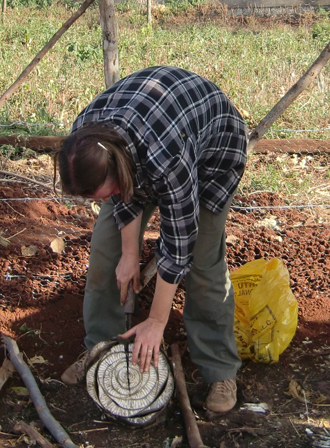
One traditional way to split enset corms before planting.
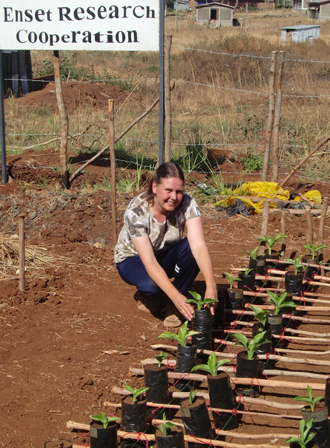
Enset seedlings grown for research in Wolaita Sodo, Ethiopia.
Emergence timing of mezereon, a shrub from cool temperate environment
Some plant species establish a proper root before the shoot emerges, which can be interpreted as an adaptation that ensures a good start for the new emerging seedling. There are several kinds of seed dormancy, different for different species, which direct the root protrusion and the shoot emergence to the right occasion of the year. A common kind of seed dormancy in this regard is "epicotyl dormancy", also referred to as "deep simple epicotyl morphophysiological dormancy". These species have embryos that are small in relation to the endosperm, and the embryo needs to grow within the seed before germination. They first require a warm period before root protrusion occurs, and then they need a cool period before shoot growth. One example is the circumboreal Viburnum opulus (guelder-rose), of which colleagues and I have studied populations from Japan, USA, and Sweden.

Ripe fruits of mezereon, just before collected by birds, which eat the flesh and distribute the kernels (seeds) to new locations.
There are, however, other solutions to achieve similar timing. In Viburnum tinus (laurustinus) embryo growth occurs at higher temperatures than the other development stages. This, together with slow development, leads to shoot emergence earliest the second spring after seed dispersal, which can easily be mistaken for epicotyl dormancy if the specific responses to different environmental circumstances are not carefully investigated.
Currently, I am studying the emergence timing of Daphne mezereum (mezereon). The species occurs in most of Europe and western Asia; in the southern parts mostly at higher elevations, and in the northern parts at lower elevations and in relatively warm microclimates. It flowers very early in spring, and fruits are dispersed in mid to late summer.
Ripe seeds of D. mezereum have embryos that occupy the entire seed volume, so the occurrence of epicotyl dormancy, described above, is not technically a possibility. When subjected to annual changing seasons, root protrusion rate was enhanced during warm seasons and reduced during colder. Thereafter, shoot emergence followed the same pattern; the entire process resulted in emergence mostly during rising temperatures in spring the second year after dispersal, which allows maximal time for growth and establishment before winter. Thus the emergence pattern of D. mezereum is the same as for species with epicotyl dormancy, but in the case of D. mezereum is due to a slow but continuous development process, not seed dormancy.
Root and rhizome germination of perennial weeds
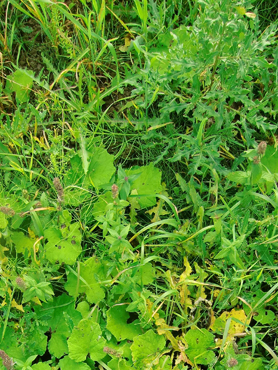
The perennial weeds Canada thistle, coltsfoot, field horsetail, perennial sowthistle, quackgrass, and other, well established in an agricultural field in Sweden.
It is a well-established method for control of perennial weeds to cultivate soil and fragmentize roots and rhizomes to stimulate emergence and destroy the new shoots in order to deplete the underground part of resources and give the crop a competitive advantage. However, this method is not always successful; sometimes it seems even contra-productive, because the fragmentation may result in a lot of new sprouts that for some reason or another outcompete the crop instead of the opposite.
Compared to seed germination, little is known about germination or sprouting of buds on roots and rhizomes. In order to understand emergence dynamics of perennial weeds, the environmental circumstances directing such sprouting should be known. To investigate temperature requirements for germination and initiation of further growth, I dug up plants of five perennial weed species (two populations of each) and planted them in pots. The weeds were Circisum arvense (Canada thistle), Elytrigia repens (quackgrass), Equisetum arvense (field horsetail), Sonchus arvensis (perennial sowthistle), and Tussilago farfara (coltsfoot). From each population, half of the pots were placed in soil outdoors during winter (in Sweden) and half in a greenhouse kept at summer temperature. Root and rhizome fragments were then tested for germination at twelve different temperatures (1/-3 to 23/19 °C day/night).
For all species and from both pre-treatment environments, buds on roots or rhizomes germinated at lower temperature than what was needed for further growth. For Circisum arvense, Equisetum arvense, and Sonchus arvensis, fragments from winter pots germinated to higher extent at low temperatures than did those from summer conditions in greenhouse.
From the results, it can be interpreted that soil cultivation at low temperatures may cause a situation where buds on root or rhizome fragments germinate but stay resting in that stage until temperature has raised enough, e.g. during spring, which can explain a seemingly inexplicably emergence flush in the field. For some species, the bud germination response to soil cultivation can only be predicted if taking into account the environment the roots or rhizomes have faced previous to the specific situation.
Tropical weeds in developing countries
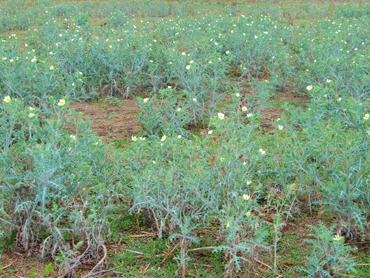
The weed Argemone ochroleuca (prickly poppy), completely infesting a crop field in Ethiopia.
Weeds are the potentially worst pest in agriculture. "Potentially" refers to a situation without functional weeds control. Without pest control, weeds cause greater loss than insects or microorganisms. Considering this, it is important to learn about the ecology of weeds in agricultural systems with little or no possibility to use herbicides or machineries for weed control; that is, in small holders farming systems in developing countries. However, most research on weeds is done in Europe and North America.
A number of my studies have included weeds occurring in tropical climate, and I have had rich opportunities to study weeds in the fields and discuss with self-subsistence farmers. Germination studies have increased the understanding of seed dormancy changes as explanation to emergence timing in environments without distinct temperature differences between seasons.
For species that in temperate climates direct germination and emergence to spring or autumn, the pattern may instead be directed by alternating dry and rainy periods in tropic climate. This can occur in species which have a kind of seed dormancy that is reduced by cold or warm stratification; in the tropic climate these seeds will not face such temperature circumstances. Instead, seed dormancy may be reduced during dry seasons. For some species, this is an efficient way to reduce dormancy, for other the effect is only weak. Therefore, some seeds germinate not as easily as they possible could if given ideal dormancy reduction conditions. In that case, only a fraction of the dispersed seeds germinate when rains come.
When seed dormancy reduction is not complete, it contributes to the building up of soil seed banks; viable seeds in the soil, ready to germinate when conditions are proper. Because of this, seeds dispersed during several seasons can germinate at one occasion. Therefore, farmers may interpret the situation as "there is no meaning to put a lot of effort to reduce seed dispersal – I did one year and it did not help at all".
To understand the weed emergence timing, and to direct the weed management to the most efficient occasion, research taking the actual environmental situation into account is required. It is also very important to keep in mind that recommendations have no meaning if nobody follows them. There must be communication with agricultural advisers and farmers to establish understanding for the process leading to weed seed germination to encourage work that may not pay off the first season.
